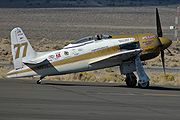
Rare Bear
Encyclopedia
Rare Bear is a highly-modified Grumman F8F Bearcat that dominated the Reno Air Races
Reno Air Races
The Reno Air Races, also known as the National Championship Air Races, take place each September at the Reno Stead Airport a few miles north of Reno, Nevada, USA...
for decades.
History
The Bearcat that became Rare Bear was a severely damaged wreck when discovered by Lyle SheltonLyle Shelton
Lyle Shelton was an American aviator who set the world's absolute propeller-driven 3-kilometer speed record of 528.329 mph. He won ten Unlimited air races, the most of any pilot, and six national championships, second only to Darryl Greenamyer...
in 1969. It had been abandoned next to a runway in Valparaiso, Indiana after it crashed there, from a torque roll, in 1962. The airplane had been stripped by parts hunters, so Shelton found a fuselage, wing center section, landing gear and a right wing panel, but little else. Shelton bought the wreck and had the pieces trucked to Orange County and restoration began. One of the major modifications made during the rebuild involved installing a more powerful Wright R-3350
Wright R-3350
The Wright R-3350 Duplex-Cyclone was one of the most powerful radial aircraft engines produced in the United States. It was a twin row, supercharged, air-cooled, radial engine with 18 cylinders. Power ranged from 2,200 to over 3,700 hp , depending on the model...
(from a Douglas Skyraider) in place of the Pratt & Whitney R-2800
Pratt & Whitney R-2800
The Pratt & Whitney R-2800 Double Wasp is a two-row, 18-cylinder, air-cooled radial aircraft engine with a displacement of 2,804 in³ , and is part of the long-lived Wasp family....
engine that is standard for a Bearcat. A Douglas DC-7
Douglas DC-7
The Douglas DC-7 is an American transport aircraft built by the Douglas Aircraft Company from 1953 to 1958. It was the last major piston engine powered transport made by Douglas, coming just a few years before the advent of jet aircraft such as the Boeing 707 and Douglas DC-8.-Design and...
propeller and cowl were used and Shelton bought the landing gear fairings and doors from the wreck of Bob Kucera's Bearcat. Bill Fornoff loaned him a left wing panel and Gunter Balz supplied a rudder. The windshield and canopy were supplied by Ed Maloney. The rebuild was finished with the first flight on 13 September 1969.
Racing career

Mojave, California
Mojave is a census-designated place in Kern County, California, United States. Mojave is located east of Bakersfield, at an elevation of 2762 feet...
, San Diego, California
San Diego, California
San Diego is the eighth-largest city in the United States and second-largest city in California. The city is located on the coast of the Pacific Ocean in Southern California, immediately adjacent to the Mexican border. The birthplace of California, San Diego is known for its mild year-round...
, Miami, Florida
Miami, Florida
Miami is a city located on the Atlantic coast in southeastern Florida and the county seat of Miami-Dade County, the most populous county in Florida and the eighth-most populous county in the United States with a population of 2,500,625...
and Cape May, New Jersey
Cape May, New Jersey
Cape May is a city at the southern tip of Cape May Peninsula in Cape May County, New Jersey, where the Delaware Bay meets the Atlantic Ocean and is one of the country's oldest vacation resort destinations. It is part of the Ocean City Metropolitan Statistical Area. As of the 2010 United States...
. In this period, he scored five victories. During the a 1976 air race in Mojave California, Shelton experienced an engine failure and had to perform a belly landing.
The aircraft was not raced again until 1980, when it was renamed "Rare Bear". From 1980 until present day, Rare Bear has scored eleven more victories in the Unlimited Class. A three-blade propeller, consisting of blades from a Lockheed P-3 Orion propeller, in a Lockheed Constellation
Lockheed Constellation
The Lockheed Constellation was a propeller-driven airliner powered by four 18-cylinder radial Wright R-3350 engines. It was built by Lockheed between 1943 and 1958 at its Burbank, California, USA, facility. A total of 856 aircraft were produced in numerous models, all distinguished by a...
hub, was fitted to the aircraft in 1988. After back-to-back testing in 2004, a switch was made back to the Aeroproducts four-bladed propeller.
In late 2006 both the plane and the team were sold to Rod Lewis for just under $2 million. Recent accomplishments include finishing the Reno Air Races in 2004 and 2005 with the gold medal in the unlimited gold race. The pilot for those two championships was John Penney. In 2006 the Rare Bear was piloted by Ron Buccarelli.
For the 2007 Reno Air Races, Rare Bear appeared in a new paint scheme. It was piloted by John Penney, who flew it to victory in the Unlimited Class Gold Race.
In the 2008 Reno Air Races, Rare Bear appeared in yet another new paint scheme.. Propeller problems during qualifying resulted in an intense all-night rebuild of the prop. The aircraft was able to qualify and John Penney made it to the Unlimited Breitling Gold race. He was in 2nd place when he was forced to mayday once again, this time trailing smoke. While Penney made it down safely, it is currently unknown how much damage was done to Rare Bear.
Before the 2009 races, the wing root mounted oil coolers were replaced with a boil-off oil cooling system. As a result, the outer half of both wing root inlets were closed off. Sporting yet another new paint scheme, Rare Bear finished 2nd in the final race with a speed of 479.088 mph (770.8 km/h).
In the 2010 races, Rare Bear finished 2nd in the Gold Heat 3A at 447.755 mph (720.6 km/h). The Gold Final race was cancelled due to weather conditions.
Records


